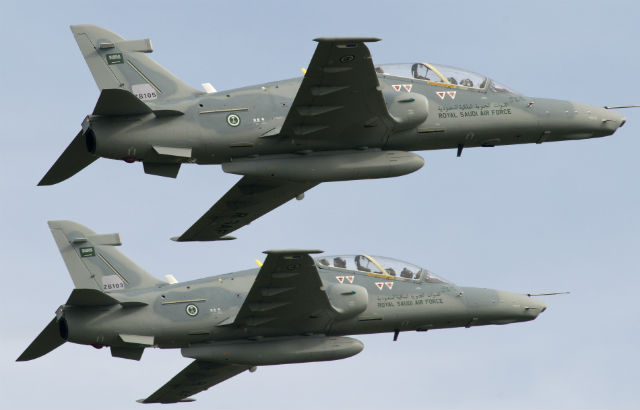BAE Systems has delivered its latest pair of Hawk advanced jet trainers to Saudi Arabia, as the company looks to attract further buyers and extend production beyond 2018.
Departing BAE’s Warton final assembly site in Lancashire on 9 June, the Royal Saudi Air Force aircraft bring the number of Mk 165 examples handed over so far this year to five, the company says. These are the lead units from a 22-aircraft order signed in 2012, with Riyadh having also signed a repeat deal late last year to double this number. The manufacturer’s current backlog also includes eight Hawk 166s for Oman.

Peter Foster
Steve Timms, managing director of defence information and training systems at BAE’s Military Air & Information business unit, notes that from a lifetime order book for 1,020 Hawks – including Boeing T-45 Goshawk derivatives produced for the US Navy – there are typically 650 aircraft in use daily. Flightglobal’s Fleets Analyzer database shows that approaching 100 of this total are in use with the Indian air force and navy.
“India’s Hawks are flying 100 sorties a day, with an 80% availability rate,” says Timms, who adds that the nation “is exploring whether it can get more out of the Hawk". This activity includes BAE working with local production partner Hindustan Aeronautics (HAL) on an advanced variant, to potentially include an updated cockpit with a large area display, and a new wing. Featuring moving slats on the leading edge, the wing would shorten take-off and landing runs and also enhance agility when carrying external stores, such as weapons or sensors.
BAE’s Hawk new development aircraft is to have the new wing installed, but BAE is tight-lipped about its plans regarding flight-testing the enhanced platform. “We want to demonstrate it within the next 12 months, to give confidence in the product,” Timms says of the development. “If we feel we need to fly we’ll fly it,” he adds.
Meanwhile, BAE is in discussions with HAL and the Indian air force and navy about establishing long-term support arrangements for the nation’s Hawks. “We want to stay in partnership,” Timms says. “We are discussing how we can support them longer-term, looking at our T2 experience [with the UK Royal Air Force].”
To cover spares, repairs and absolescence management, this support arrangement is likely to be advanced through a proposed new joint venture with HAL, which also would encompass the Indian air force’s fleet of Sepecat Jaguar ground-attack aircraft.
Source: FlightGlobal.com























